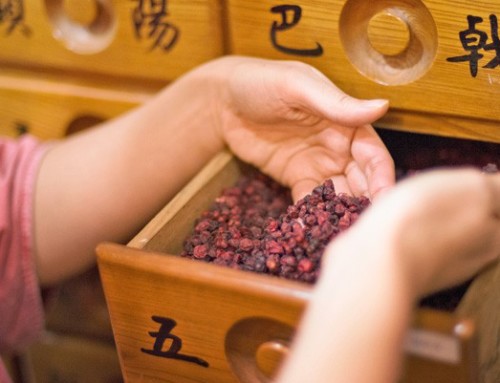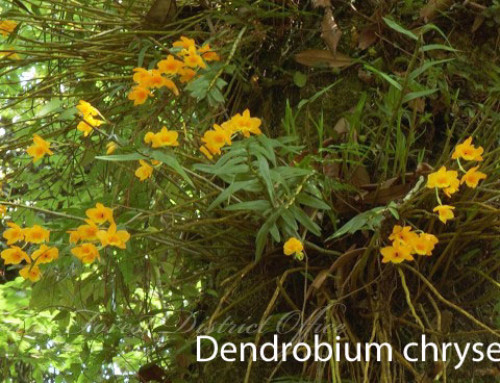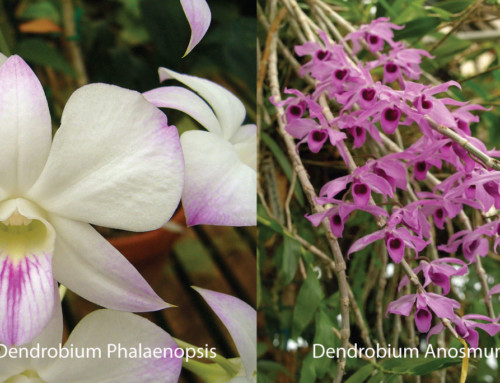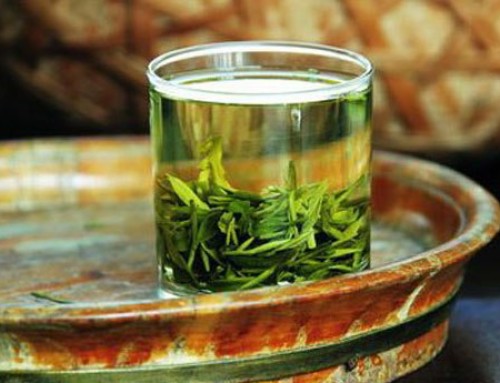Chinese tea categories are a little different in Chinese than in English which can create some confusion. Black tea in English is called red tea (hóng chá 红茶) because the color of the brewed tea is reddish. Dark or black tea (hēi chá 黑茶) in Chinese refers to a category of post-fermented teas historically popular amongst Chinese minority populations who eat higher amounts of meat. It was also used as tribute tea because dark tea gets better with age, like wine, and could weather the long journeys. Dark tea includes Pu’er tea (pǔ’ěrchá 普洱茶) from Yunnan Province, Fuzhuan from Hu’nan, Qingzhuan from Hubei, and Liubao cha from Guangxi. Pu’er has become popular in the past decade as a collector’s item and health drink.
Health Benefits of Pu’er Tea
Pu’er is used to counteract the heavy nature of meat during meals, helps lower cholesterol (especially when brewed with Chrysanthemum flowers), aids weightloss, improves blood circulation, protects against cancer, is antiaging, and reduces hypertension. The enzymes used to process pu’er aid digestion and regulate bowel movements.*
Taste of Pu’er
Ripe pu’er has a mellow, earthy fragrance and taste and produces a dark red tea liquid. Raw pu’er produces a lighter tea liquid and the taste varies with age. Young (under 5 years old) raw pu’er has a distinct astringency and bitterness and produces a yellow tea liquid. After 5 years it begins to darken and mellow and increase in complexity. The flavor continues to improve as it is aged 20+ years.
Types of Pu’er
Tea made from small tender leaves is considered better quality and more expensive (this is true in all tea categories) than tea made from large leaves. The picking standard of high quality teas typically includes 1 bud and 1-2 leaves. Premium teas are less bitter, more subtle, and more complex than cheap tea. Interestingly, my teachers all preferred using low quality, bitter tea for medicine claiming the action was more potent.
The tea plant (Camellia sinensis) began as a large tree and evolved into smaller trees and shrubs. All continue to be cultivated for tea. Pu’er is divided into that made from old arbor trees, young trees, bushes, and geography, all of which affect the taste profile.
 Raw Pu’er is made by drying the tea leaves and compressing them into cakes, blocks, or other shapes. They are then aged for at least 5 years (and up to 20-30 years). During this time natural bacteria transform the tea’s taste and properties. Raw pu’er under 5 years of age looks green and is astringent tasting and a bit harsh, though some enjoy it at this stage. After about 5 years of proper storage the tea begins to mellow and darken. At 10 years or over the tea becomes earthy, mellow, and complex. Aged raw pu’er is more expensive. The issue I have is that when I buy raw pu’er I feel pressured to save it, like I would a good quality wine, and end up not drinking it as often as ripe pu’er. Raw and ripe pu’er are like two different types of tea and I enjoy them both.
Raw Pu’er is made by drying the tea leaves and compressing them into cakes, blocks, or other shapes. They are then aged for at least 5 years (and up to 20-30 years). During this time natural bacteria transform the tea’s taste and properties. Raw pu’er under 5 years of age looks green and is astringent tasting and a bit harsh, though some enjoy it at this stage. After about 5 years of proper storage the tea begins to mellow and darken. At 10 years or over the tea becomes earthy, mellow, and complex. Aged raw pu’er is more expensive. The issue I have is that when I buy raw pu’er I feel pressured to save it, like I would a good quality wine, and end up not drinking it as often as ripe pu’er. Raw and ripe pu’er are like two different types of tea and I enjoy them both.
In the 1980’s a new method of pile fermentation was developed to speed up the fermentation process of pu’er tea. This is called Ripe Pu’er. It does not need to be aged and can be enjoyed immediately. It can be stored for long periods of time. The tea liquid is dark red and the flavor is mellow and earthy, and less complex and variable than raw pu’er. Ripe pu’er is cheaper and often a better choice for those who want a daily drink for health benefits.
Loose Pu’er can be raw or ripe. It has been packed loose rather than formed into cakes or bricks.
Zhutong Cha is tea processed in bamboo stalks. This mellows the taste and adds complexity. Various parts of the bamboo plant are used in Tradtional Chinese Medicine TCM to clear Heat and resolve Phlegm.
Old Tea Lump (Lao Cha Tou) are clumps that develop from pile fermentation in the production of ripe pu’er. These clumps are unevenly fermented and removed from the pile. They retain qualities of both ripe and raw pu’er. It is more fragrant and complex than regular ripe pu’er.
Flowers can be added to pu’er to enhance the taste and health benefits. As mentioned before, Chrysanthemum flowers are added for cholesterol and hypertension issues. Rose flowers pair very well with the earthy pu’er tea and helps aid circulation and stress-relief.
*This is what has been studied and reported in China. These claims have not been reviewed by the FDA.






